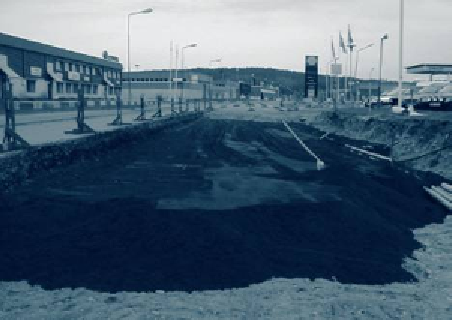Environmental Engineering Reference
In-Depth Information
the smelting furnaces. Dust from the bag filters and metals precipitated in the wastewater
treatment plant are also fed to flash smelting furnaces as secondary materials. A fine
example of internal waste material management is the Mitsubishi Continuous Smelting
technology that practically eliminates the production of hazardous solid waste in copper
production (
Case 6.8
).
Liquid Emissions
Liquid wastes in pyrometallurgical operations range from wash water to effluent from wet
scrubbers in air emission controls. Efforts are made to recycle water to the maximum pos-
sible extent. However, it is practically impossible to operate a closed circuit system without
allowing for a bleed-off stream to avoid the build up of dissolved solids and/or a consistent
decrease or increase in pH. Liquid effluent treatment wastes and residues also result from
treatment of wastewater streams. Process water from processing usually requires cleaning
in a wastewater treatment plant. The cleaning takes place by neutralization and precipita-
tion of specific ions. The main wastes/residues from these effluent treatment systems are
gypsum (CaSO
4
), and metal hydroxides and sulphides.
It is practically impossible to
operate a closed circuit system
without allowing for a bleed-
off stream to avoid the build
up of dissolved solids and/or a
consistent decrease or increase
in pH.
6.5 HYDROMETALLURGY AND RELATED ENVIRONMENTAL
CONCERNS
Hydrometallurgical operations are chemical operations, with their own set of environmen-
tal challenges. The main environmental challenges are the production of various waste
streams, including spent ore, and the management of leaching solution and water, includ-
ing maintaining the integrity of liners.
CASE 6.7
Concerns about Assumed Risks as Barrier to
Wider Use of Alternative Materials
Copper smelter slag is used worldwide
as an alternative material. The Minerals
and Metals Policy of the Government of
Canada, 1996 promotes the use of slag as
alternative materials. In Germany copper
slag from the NA smelter in Hamburg is a
preferred material for dyke construction. In
Sweden granulated slag from the Rönnskär
smelter is widely used as a fi ll material
and sub-base in thickness between 30 and
70 cm for road construction as shown the
photograph. The granulated slag marketed
as Iron Sand reveals good heat insulat-
ing and draining qualities, which makes it
particularly suitable for road- and ground-
constructions in cold climates. Iron Sand has
been used for over 30 years for this pur-
pose in the Skellefteå region (Borell 2005).
It is estimated that in Skellefteå alone at
least 100 km of road and about 80,000 m
2
of industrial areas are built on copper slag.
In other parts of the world granulated
copper slag is labelled as waste, a regula-
tory barrier to wider use. As one example,
the Indonesian Government continues to be
one of the most out-spoken critics of the
use of copper slag, and continues to label
copper slag as hazardous and toxic material.
Photo Credit: Borell 2005









Search WWH ::

Custom Search